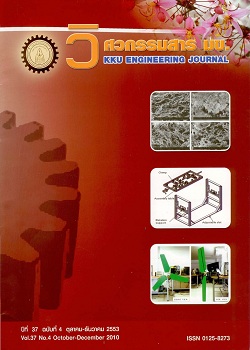Rotor-Speed Control-System Design for Small Wind Turbine by using the PID Controller Techniques
Main Article Content
Abstract
Wind turbine technology has changed tremendously in the past twenty five years. Most of the windturbines, which are currently designed or installed, have some rotor speed control systems as their significantcomponents. The most popular control technique is rotor speed control by adjusting the blade|s pitch angle.At low wind speed, good rotor speed control is important to obtain a specific rotor speed to generate as highelectricity as possible for that specific wind speed. At high wind speed, good rotor speed control is importantto maintain a constant rotor speed so that the resulting electricity is constant without any jerk. This will result inbetter-quality electricity. The rotor speed control system is mainly installed in large wind turbines only. Thisresearch designs the rotor speed control system of a small wind turbine. A small-scaled wind turbine wasdesigned and built with 1.14 meters in diameter. This wind turbine has the same structure and components asthe regular wind turbine, but it cannot generate electricity. A mechanism to adjust the blade pitch angle wasdesigned and installed without adding more weight to the rotor. As a result, the wind turbine can be operatedat the same wind speed range but with higher efficiency. The rotor speed control system was created from aPID controller, which is not complicated and is well-known in the industry. There are two cascading loops inthe control system, namely the inner and the outer loops. The inner loop controls the pitch angle, and the outerloop controls the rotor speed. The experimental result has shown that the wind turbine was able to follow thedesired speed closely and is able to robustly maintain the speed very well in the presence of the disturbancefrom the changing wind.
Article Details
How to Cite
Srivongsa, T., & Chatlatanagulchai, W. (2012). Rotor-Speed Control-System Design for Small Wind Turbine by using the PID Controller Techniques. Engineering and Applied Science Research, 37(4), 329–338. retrieved from https://ph01.tci-thaijo.org/index.php/easr/article/view/1721
Issue
Section
ORIGINAL RESEARCH
This work is licensed under a Creative Commons Attribution-NonCommercial-NoDerivatives 4.0 International License.



